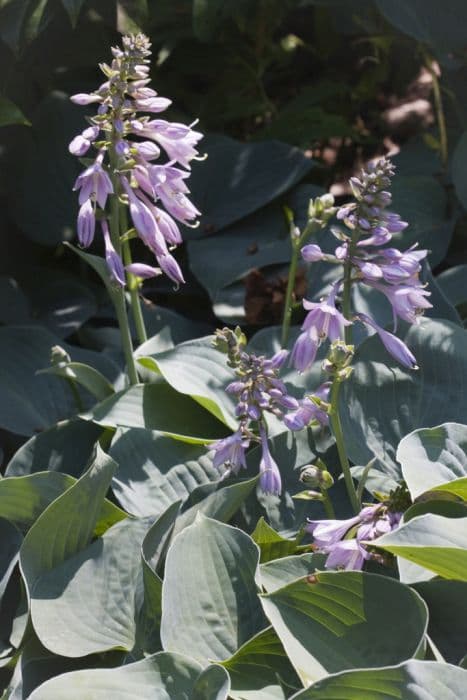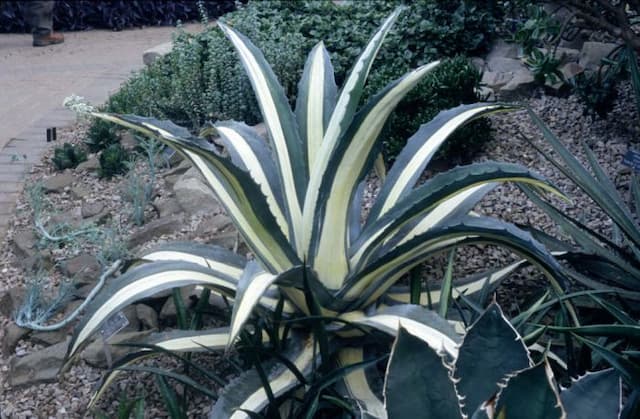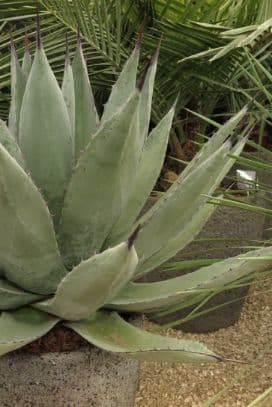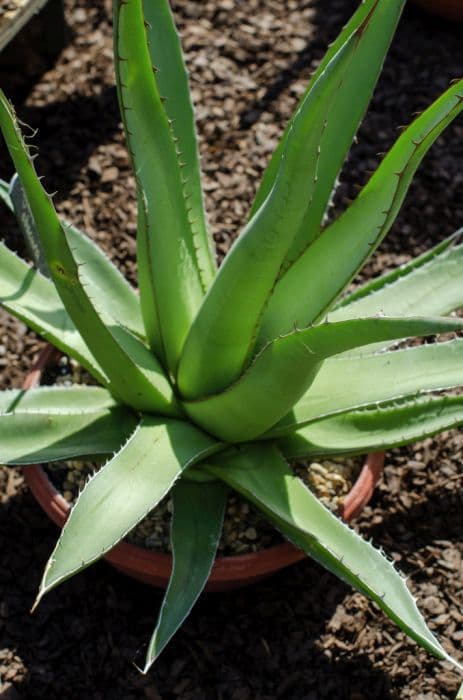Hosta Hosta 'Blue Cadet'

ABOUT
Hosta 'Blue Cadet' is a herbaceous perennial that is well-regarded for its lush foliage and shade tolerance. This plant has a striking appearance, characterized by its heart-shaped leaves that are noted for their rich blue-green hue. These leaves often have a prominent vein structure and a somewhat puckered texture, giving them a quilted look. The leaves are arranged in a mounded fashion, emerging from the base of the plant and arching outward gracefully. During the blooming period, 'Blue Cadet' produces delicate flower stalks that rise above the foliage. The blooms are bell-shaped and typically come in a shade of lavender, adding a soft, subtle contrast to the bold leaf coloration. These flowers are known to attract pollinators such as bees and hummingbirds to the garden. Over time, the 'Blue Cadet' can form dense clumps, creating an impressive display of color and texture in garden spaces designed for visual interest and low maintenance.
About this plant
 Names
NamesFamily
Asparagaceae
Synonyms
Plantain Lily, Funkia
Common names
Hosta 'Blue Cadet'.
 Toxicity
ToxicityTo humans
Hostas, including the 'Blue Cadet' variety, are not considered toxic to humans. However, as with any non-food plant, ingestion of parts of the hosta plant can potentially cause discomfort or an upset stomach due to the plant's fibrous nature.
To pets
Hostas are toxic to pets, such as dogs and cats. If a pet ingests parts of a hosta plant, they may experience symptoms such as vomiting, diarrhea, and depression due to the saponins present in the plant. It's essential to keep hostas out of reach from pets to avoid these possible consequences.
 Characteristics
CharacteristicsLife cycle
Perennials
Foliage type
Deciduous
Color of leaves
Blue-green
Flower color
Lavender
Height
1 foot (30 centimeters)
Spread
2 feet (60 centimeters)
Plant type
Herb
Hardiness zones
3
Native area
Asia
Benefits
 General Benefits
General Benefits- Shade Tolerance: Thrives in shady areas where other plants might struggle.
- Low Maintenance: Requires minimal care once established, making it ideal for busy gardeners.
- Attractive Foliage: Offers lush, blue-green leaves that add texture and color to gardens.
- Ground Cover: Dense foliage spreads to cover ground and suppress weeds.
- Seasonal Interest: Develops tall flower spikes in summer, adding vertical interest.
- Drought Resistance: Once established, can tolerate periods of low water availability.
- Hardiness: Survives in a wide range of climates and is resistant to cold temperatures.
- Long-Lived: Can thrive for many years with proper care, providing long-term landscaping benefits.
- Pest Resilience: Resistant to many common garden pests like deer and rabbits.
- Versatility: Suitable for a variety of garden styles, including borders, woodland gardens, and container planting.
 Medical Properties
Medical PropertiesThis plant is not used for medical purposes.
 Air-purifying Qualities
Air-purifying QualitiesThis plant is not specifically known for air purifying qualities.
 Other Uses
Other Uses- Container gardening: Hosta 'Blue Cadet' is small enough to be used in container plantings, adding texture and color to patios, decks, and balconies.
- Fairy gardens: Their diminutive size and attractive foliage make them suitable for inclusion in whimsical fairy gardens.
- Bonsai: While not traditional, Hosta 'Blue Cadet' can be trained and maintained as a bonsai plant for an unusual take on this Japanese art form.
- Flower arrangements: The leaves of Hosta 'Blue Cadet' can be used to add a bold, leafy contrast in cut flower arrangements.
- Ground cover: This plant can be used as ground cover in shady areas where grass might struggle to grow.
- Edging plants: The tidy growth habit of Hosta 'Blue Cadet' makes it effective for edging along paths or border fronts.
- Shade garden texture: Their unique foliage provides texture variation among other shade-loving plants in textured garden designs.
- Photography: The lush foliage and subtle flower spikes can be used as subjects or backdrops for macro photography.
- Hosta Shows: Enthusiasts may grow Hosta 'Blue Cadet' for display at plant shows, highlighting the variety's characteristics.
- Teaching tool: Can be used to teach about plant division and propagation in educational settings.
Interesting Facts
 Feng Shui
Feng ShuiThe Hosta is not used in Feng Shui practice.
 Zodiac Sign Compitability
Zodiac Sign CompitabilityThe Hosta is not used in astrology practice.
 Plant Symbolism
Plant Symbolism- Devotion: Hostas are often seen as a symbol of devotion because of their lush foliage and the way they return more vigorously each year, representing the growing dedication in a relationship.
- Heartiness: Hosta plants, including the 'Blue Cadet', are known for their resilience and adaptability, suggesting the trait of being able to withstand challenges.
- Friendship: Due to their shade-loving nature and propensity to grow well alongside other plants, hostas can symbolize the supportive nature of friends.
- Longevity: Hostas live for many years and often increase in beauty over time, making them a symbol of longevity and enduring presence.
- Peace: The broad leaves of the Hosta 'Blue Cadet' provide a calming green space, evoking a sense of tranquility and peace in the garden.
 Water
WaterHostas, including the 'Blue Cadet' variety, prefer evenly moist soil, so it's important to water them thoroughly. On average, provide about an inch of water per week, which translates to about 0.623 gallons for a square foot. During hot or dry periods, you may need to water the plants more frequently, possibly twice a week, to maintain consistent soil moisture. Avoid overhead watering to minimize the risk of leaf diseases; instead, water at the base of the plant early in the day. It’s also beneficial to use mulch to help retain soil moisture and reduce the need for frequent watering.
 Light
LightHostas, such as the 'Blue Cadet', thrive in partial to full shade. The best location is one where morning sunlight may be present, but with protection from the harsh afternoon sun. Dappled shade under trees or a northern exposure often provides ideal light conditions for this perennial to maintain its vibrant foliage and overall health.
 Temperature
Temperature'Blue Cadet' hostas grow best in environments where the temperature ranges from 40°F to 85°F. They can survive a minimum temperature down to about 30°F and can handle occasional spikes above 85°F, as long as they are well-watered and not in direct sun. Optimal growth for Hostas typically occurs when temperatures are between 50°F and 75°F.
 Pruning
PruningPrune 'Blue Cadet' hostas to remove dead or damaged foliage throughout the growing season as needed to maintain plant health and appearance. Large-scale pruning should happen in the fall after the leaves have died back or in the early spring before new growth starts. Pruning is also an opportunity to control plant size and remove flower stalks after blooms have faded, if desired.
 Cleaning
CleaningAs needed
 Soil
SoilHostas prefer moist, well-draining soil with high organic matter. A mix of one part garden soil, one part peat moss, and one part perlite or coarse sand works well for 'Blue Cadet'. The ideal pH for this hosta is between 6.0 and 7.5.
 Repotting
RepottingHostas like 'Blue Cadet' typically need to be repotted every 3 to 5 years. This allows for refreshing the soil and dividing the plant if it has become too large for its container.
 Humidity & Misting
Humidity & Misting'Blue Cadet' hostas thrive in average to high humidity environments, comparable to their natural forest understory habitats. Aim for a humidity level of 50% or higher for optimal growth.
 Suitable locations
Suitable locationsIndoor
Grow in bright, indirect light, water when topsoil feels dry.
Outdoor
Plant in dappled shade, ensure soil is rich and well-draining.
Hardiness zone
3-9 USDA
 Life cycle
Life cycleHosta 'Blue Cadet', commonly known as Plantain Lily, begins its life cycle as a dormant rhizome, which is planted in moist, well-drained soil in early spring or fall. In springtime, shoots emerge from the rhizome and develop into a clump of heart-shaped, blue-green leaves that can reach 12 inches in height. Throughout the growing season, the foliage spreads and creates a ground cover; this perennial thrives in partial to full shade. In early to midsummer, the Blue Cadet produces delicate stalks of bell-shaped lavender flowers that rise above the foliage, attracting pollinators. After blooming, the energy is directed back to the rhizome to prepare for dormancy. The plant enters a period of dormancy in the late fall or early winter as the leaves die back, and it remains dormant until the next spring when the cycle begins anew.
 Propogation
PropogationPropogation time
Spring to summer
The Hosta 'Blue Cadet', commonly known as the Blue Cadet Hosta, is best propagated through division. This process is ideally carried out in the spring or early fall when the plant is not in active growth. To propagate by division, you should carefully dig up the established clump and use a sharp knife or spade to cut the root mass into smaller sections, each with several shoots and ample root system. These divisions can then be replanted at the same depth they were originally growing, spaced approximately 12 inches (30 centimeters) apart to allow for growth and air circulation. Water the newly planted divisions thoroughly to help establish them. This method of propagation not only helps to create new plants but also rejuvenates older clumps that may have become too dense.









